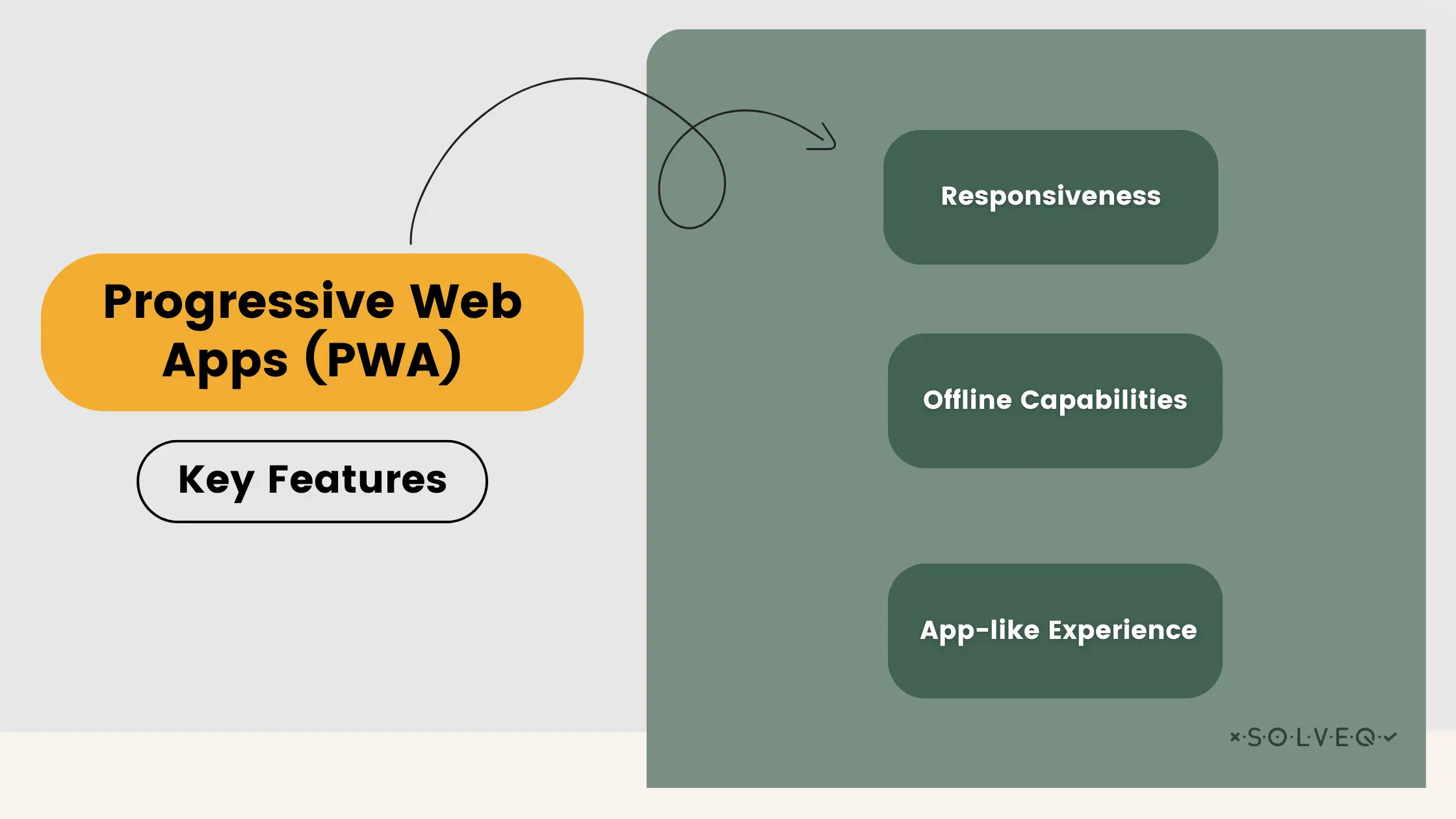PWA vs Native vs Cross-Platform: Navigating the Mobile App Landscape
16 Jan 2024 • 12 min read

Marcin Kulawik

The mobile app industry, rapidly approaching a staggering $935 billion in revenue by 2023, has evolved dramatically with the advent of Progressive Web Apps (PWAs), Native, and Cross-Platform applications. Each approach offers unique advantages: PWAs combine web accessibility with app-like functionality, while native apps excel in performance, and cross-platform solutions provide versatility. This article aims to provide a concise yet thorough insight into these methodologies, so managers and decision-makers can make more informed choices.
What are Progressive Web Apps (PWA)
Progressive Web Apps (PWAs) blend the best of web and mobile app features. They are application software delivered through the web, built using HTML, CSS, and JavaScript, and are designed to work on any platform with a standards-compliant browser.

Key Features:
- Responsiveness: Seamlessly adapts to different screen sizes.
- Offline Capabilities: Uses service workers for offline use or on low-quality networks.
- App-like Experience: Can be added to home screens, send push notifications, and access certain hardware features.
PWAs offer an engaging user experience similar to native apps but with the accessibility and ease of web applications.
The advantages of PWAs are significant:
- Lower Development Costs: They require a single codebase for multiple platforms, reducing both time and cost.
- No App Store Dependence: Direct web deployment eliminates app store restrictions and fees.
- Easy Updates: Updates are deployed directly to the web server, ensuring all users have immediate access to the latest version.
However, PWAs face certain limitations:
- Their access to hardware and device features is not as comprehensive as native apps.
- Performance, especially for complex applications, may not be as smooth as native apps.
Ideal use cases for PWAs include applications where broad accessibility and regular updates are crucial. They are particularly suitable for small to medium-sized businesses looking to establish a mobile presence without a significant investment. Examples include news sites, e-commerce platforms, and personal portfolios.
In conclusion, PWAs present a cost-effective, versatile, and user-friendly solution, making them an increasingly popular choice in the mobile app development space.
Native Mobile Applications
Native mobile applications are specifically designed and developed for a particular mobile operating system, such as iOS or Android. Utilizing the development tools and languages native to each platform (like Swift for iOS or Kotlin for Android), these apps can fully leverage the capabilities of the specific operating system they're built for.

Key Features:
- Full Device Integration: Native apps can deeply integrate with the device's hardware and software, offering a seamless experience.
- High Performance: Optimized for their specific platform, they typically perform better, especially in graphics-intensive applications or games.
- Specific UI/UX: These apps adhere to the design guidelines of their respective platforms, ensuring a consistent user interface that users are familiar with.
The advantages of native apps are clear, particularly in terms of user experience and performance:
- Speed: They are generally faster and more responsive, providing a smoother user experience.
- Reliability: Being designed for a specific platform, they tend to be more stable and reliable.
- Access to Device Features: Native apps can fully access and utilize the device's hardware and software features like camera, microphone, GPS, etc.
However, there are some limitations to consider:
- Higher Cost: Development can be more expensive, particularly if building separate apps for different platforms.
- Platform-Specific Development: Requires development expertise specific to each platform, which can be resource-intensive.
Ideal Use Cases for Native Apps:
- Applications requiring intensive use of device features like augmented reality or high-quality gaming.
- Apps where performance and speed are critical, such as complex financial or business applications.
- Projects where the budget allows for the development of multiple platform-specific versions.
In summary, native mobile applications offer performance and user experience tailored to specific platforms. They are ideal for applications where speed, reliability, and full use of device capabilities are paramount, albeit at a higher development cost and effort.
Cross-Platform Mobile Applications
Cross-platform mobile applications are developed using a unified codebase that can run across multiple mobile operating systems, such as iOS and Android. These apps are built using frameworks like React Native, Flutter, or Xamarin, which allow developers to write the app's code once and deploy it on multiple platforms. This approach bridges the gap between native and web applications, offering a middle ground in terms of performance and user experience.

Key Features:
- Code Reusability: The same code can be used across different platforms, significantly reducing repetitive coding efforts.
- Broader Audience Reach: Since these apps can run on multiple platforms, they can reach a wider audience.
- Uniformity Across Platforms: Cross-platform apps provide a consistent look and feel across different devices, which is beneficial for brand consistency.
Mani advantages:
The advantages of cross-platform apps are primarily centered around efficiency and reach:
- Cost-Effectiveness: Development costs are reduced as the same codebase serves multiple platforms.
- Faster Development Time: The time to market is quicker due to the shared development process for iOS and Android.
Mani disadvantages:
However, there are some notable limitations:
- Performance Issues: These apps may not be as performant as native apps, especially for high-end graphics or animation.
- Limited Customization: Access to device-specific features and customization can be more limited compared to native apps.
Ideal Use Cases for Cross-Platform Apps:
- Businesses seeking to launch an MVP (Minimum Viable Product) to test the market.
- Applications where the speed of development and budget constraints are prioritized over advanced performance.
- Projects that require a consistent user experience across multiple platforms but do not demand intensive use of device capabilities.
In conclusion, cross-platform mobile applications present an efficient solution for businesses and developers looking to target multiple platforms with a single codebase. While they offer cost-effectiveness and broader reach, they might not always deliver the same level of performance and deep integration as native apps. They are ideal for projects where rapid development and cost savings are more critical than achieving the highest level of device optimization.
Cross-Platform - A Versatile Solution in App Development
Cross-Platform mobile applications are becoming a pivotal part of the app development landscape, uniquely combining the benefits of both native and web-based approaches. These applications are developed using frameworks like React Native or Flutter, which allow for a single codebase to be used across multiple platforms, thus offering a perfect blend of efficiency and broad accessibility.
Bridging the Gap:
- Cross-platform apps provide a uniform user experience across different operating systems.
- They balance between the deep integration of native apps and the universal accessibility of web applications
The rise of cross-platform apps is evident in their widespread adoption across various industries:
Case Studies:
- Instagram: A prime example of a cross-platform app, Instagram maintains consistent functionality and design across iOS and Android, thanks to React Native.
- Airbnb: Another successful case, Airbnb utilized cross-platform development for efficient maintenance and updates on both major mobile platforms.
Future Outlook:
The future of cross-platform apps is promising, with advancements in development tools enhancing their capabilities and performance. While there may be some trade-offs in customization and peak performance compared to native apps, the benefits in cost and time efficiency make them an attractive choice for many businesses.
While cross-platform apps address many development challenges, they may face limitations in performance and customization compared to native apps. Despite this, their advantages in cost-effectiveness and faster development cycles make them a highly attractive option for businesses and developers. As technology advances, cross-platform development is expected to play a crucial role in shaping the future of mobile applications.
Making the Right Choice
When deciding between PWAs, Native, and Cross-Platform apps, it's essential to align your choice with your business needs, target audience, and budget. Cross-platform development emerges as a particularly viable option for many due to its blend of efficiency and broader market reach.
Considerations:
- Business Goals: Cross-platform apps are ideal for projects aiming for quick market entry and broad audience reach.
- User Preferences: These apps cater to users across different platforms without compromising on user experience.
- Budget: They offer a cost-effective solution for businesses looking to develop apps without the high expense of native development for multiple platforms.
Expert opinions and industry trends suggest a growing preference for cross-platform apps due to their balance of performance, reach, and development cost. Making the right choice involves evaluating these factors and leveraging the flexibility and efficiency of cross-platform development to meet your business objectives and capture a wider audience.
Summary
In this article, we've explored the distinctive attributes and applications of Progressive Web Apps (PWAs), Native, and Cross-Platform mobile applications in the rapidly growing app market, valued at $407 billion in 2023. While PWAs blend web ease with app functionality and native apps excel in performance, Cross-Platform solutions stand out for their ability to balance broad market reach with developmental efficiency. Suppose you're looking to harness the potential of cross-platform applications for your business. In that case, our team at SolveQ specializes in building versatile, high-performing cross-platform content that meets diverse business needs. Contact us to bring your app vision to life.
Share:
Looking for expert development team?
Schedule a call with Tech Consultant

Marcin Kulawik
Founder and CEO of SolveQ. Huge fan of building things with purpose, agility, and having fun while changing the World. Loves his family, teammates, and nature.